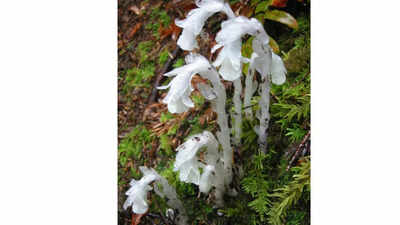Japan’s mysterious ghost plants may hold the secret to how life adapts, survives, and grows in darkness |

Hidden within Japan’s ancient forests, where sunlight struggles to reach the ground, grows one of nature’s most mysterious plants known as the ghost flower. These delicate, translucent white blossoms glow faintly in the dim light, giving them an otherworldly beauty. Unlike most plants, ghost flowers lack chlorophyll and cannot perform photosynthesis. Instead, they survive by drawing nutrients through underground fungal networks connected to nearby trees. This unusual way of life challenges the basic rules of plant biology, showing that not all plants need sunlight to thrive. The ghost flower’s existence reveals how life can adapt in remarkable ways, thriving in darkness where other species would perish and reminding us of the hidden complexity within forest ecosystems.
Japanese scientist’s childhood discovery of ghost plants
For Japanese botanist Kenji Suetsugu, the story of ghost flowers began long before his scientific career. When he was just five years old, he was walking with his family through the Kasugayama Primeval Forest in Nara. Amid the moss and fallen leaves, young Suetsugu spotted a small cluster of pale, translucent blossoms shimmering in the dim light. That brief encounter left a lasting impression on him, planting the seeds of a lifelong fascination with these mysterious organisms.Decades later, Suetsugu has become one of the world’s foremost experts on these plants, scientifically known as mycoheterotrophs. As a professor at Kobe University, he has dedicated his career to understanding how these plants survive, reproduce, and interact with the ecosystems hidden beneath the soil. Combining traditional field exploration with advanced molecular analysis, his research has changed how scientists view the hidden world of plants that live in darkness.
How ghost flowers survive without sunlight
Unlike most plants that rely on sunlight to produce energy through photosynthesis, ghost flowers lack chlorophyll, the pigment that enables plants to convert light into food. Instead, they survive through a remarkable and rather deceptive process. Their roots form complex relationships with fungi, tapping into underground networks known as mycorrhizal systems.These fungal networks usually connect to trees, sharing nutrients in a mutually beneficial exchange. However, ghost flowers take a different approach. Rather than participating in this exchange, they steal carbon and nutrients from the fungi, which in turn draw sustenance from the surrounding trees. This makes ghost flowers parasitic plants, thriving by exploiting the energy produced by other organisms rather than generating their own.Scientists have discovered that this unusual lifestyle evolved independently over 40 times throughout plant history, proving that it offers a powerful survival advantage in dark, nutrient-rich environments.
Rarity and hidden beauty of ghost plants
There are currently about 600 known species of fully mycoheterotrophic plants, and nearly half of them are orchids. These plants are exceptionally rare and difficult to study because they bloom for only a few days each year. Their fleeting appearance, combined with their hidden habitats in dense, shaded forests, makes them a challenge even for experienced botanists to locate.Their beauty, however, has captivated scientists and nature enthusiasts alike. With their glass-like petals and pale glow, ghost flowers seem like living sculptures carved from light. But beneath their fragile appearance lies a sophisticated survival mechanism that has evolved over millions of years.
Secret reproductive strategies of ghost flowers
Kenji Suetsugu’s research has revealed many secrets about how these plants reproduce. For a long time, scientists believed that ghost flowers relied on the wind to disperse their seeds. However, through the use of motion-triggered cameras placed in Japan’s dense forests, Suetsugu discovered that camel crickets play a vital role in this process.These nocturnal insects consume the seed-filled fruits of the ghost flowers, and later, after digestion, they excrete the seeds in new locations. This helps the plants spread to different parts of the forest floor, ensuring their continued survival in challenging conditions.Suetsugu’s studies have also shown that ghost flowers depend on an unlikely variety of pollinators. Tiny creatures such as spiders, ants, and woodlice, some measuring only a centimetre long, help transfer pollen between the blossoms. In some species, when pollinators are scarce, the plants have evolved a remarkable mechanism called delayed selfing. This allows them to fertilise their own flowers after a certain period, guaranteeing reproduction even in isolation.
Discovering new species and a rare plant genus in Japan
Suetsugu’s work has not only uncovered the behaviour of these plants but has also led to the discovery of new species and even new genera.In 2022, he identified a pale-pink orchid called Monotropastrum kirishimense, found only in western Japan. For decades, it had been mistaken for a more common species. Working alongside Masayuki Ishibashi, a retired teacher and orchid enthusiast, he also confirmed a new species known as Spiranthes hachijoensis, part of the “ladies’ tresses” group of orchids.Perhaps his most remarkable achievement came in 2024, when Suetsugu, together with plant ecologist Yasunori Nakamura, announced the discovery of Relictithismia kimotsukiensis, a new genus of vascular plant. This was an extraordinary moment in Japanese botany, marking the first time since 1930 that a new genus had been recorded in the country.Each of these discoveries is the result of years of fieldwork, collaboration, and meticulous observation. They reflect the balance of persistence, curiosity, and chance that often defines great scientific breakthroughs.Also Read | 3I ATLAS might expose the universe’s greatest mystery by October 30 and it could finally prove ‘we’re not alone’






